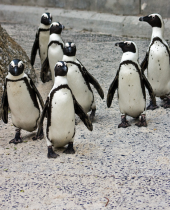Here are five that I always enjoy seeing and that I think you will also like to look for:
1. The Cape Sugarbird
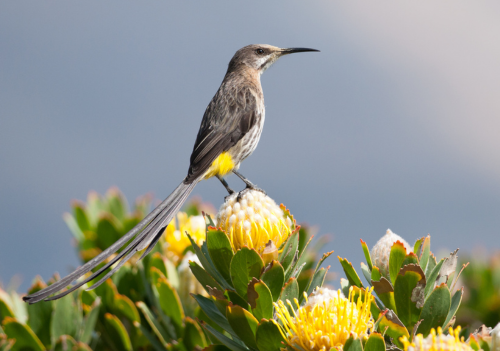
The Cape Sugarbird is a fascinating endemic songbird of the Cape. It is fair-sized considering its really long tail – especially on the male – and feeds on nectar, using its long, curved beak to enter deep into the favored flowers, its brush-tipped tongue capturing the sweet fluid. In return, the flowers also deposit pollen on its body which will fertilize the next flower on its feeding schedule. We will likely encounter it feeding on various flowering Protea, a group of blooming shrubs that also define the Cape!
2. Blue Crane
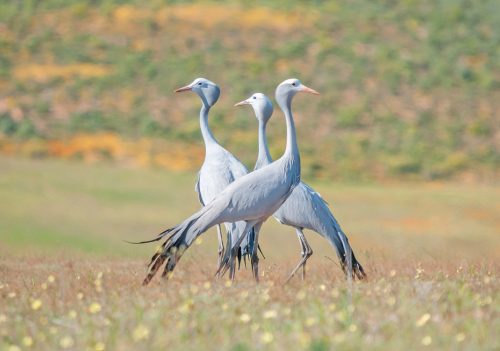
The weirdly-plumaged but magnificent Blue Crane, which is in reality a dusty bluish-gray in good light, is another iconic species of bird for the Western Cape – notable as well for being South Africa’s national bird. What appears to be a long, streaming tail is in actuality the bird’s flight feathers, which hang to the ground while it forages in open areas especially near edges of wetlands. These extended wing feathers make them graceful in their flights. Like other cranes, they are omnivores. As their range is almost completely within South Africa, it is considered a near-endemic species of the country.
3. African Penguin
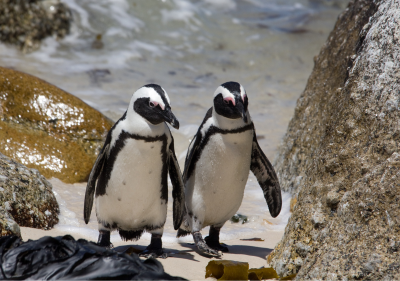
The African Penguin breeds almost entirely in South Africa, and we should watch for it notably at Betty’s Bay near Cape Town (the most accessible colony). As one might imagine, this is a coastal species relying on the sea for its food. The main colonies have been greatly reduced by almost 90%, mostly due to pollution and over-fishing, so are rarely encountered except at the mentioned location. You will be captivated as you walk next to the colony, intently watching them as they waddle about and interact with each other.
4. Orange-breasted Sunbird
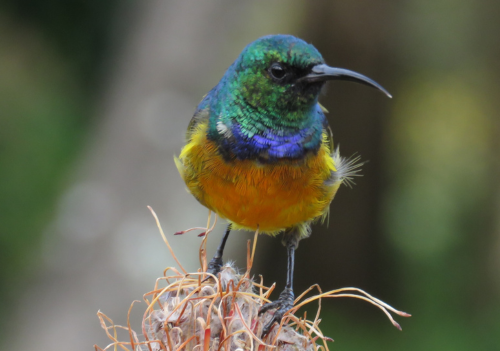
(Photo credit: Prosthetic Head)
This colourful songbird is endemic to the Cape. The blend of colors on the body of the male is exquisite, with iridescent head colors in the green-blue spectrum complementing the hot orange-yellow of the breast. Like the Cape Sugarbird, it is specially adapted as a nectar-feeder, using its long, curved beak to dip well into its chosen flowers, such as proteas and heathers. Despite its restricted range, it is quite common and will be a sure addition to the list of birds we will see.
5. Cape Rockjumper

(Photo credit: Matthew Wridgway)
The Cape Rockjumper satisfies all aspects of what an iconic bird should be – it is colourful, endemic to the southern Cape area, and fun to watch. It prefers the higher altitudes and steep rocky alpine habitats where it rarely flies, preferring to run and jump in pursuit of its prey, which includes arthropods but also small reptiles and amphibians. Because it nests on the ground, it is vulnerable to predation. Birds defend territories year-round and, interestingly, they actually thrive in areas that have been subject to recent fires.
Bonus: Southern Red Bishop
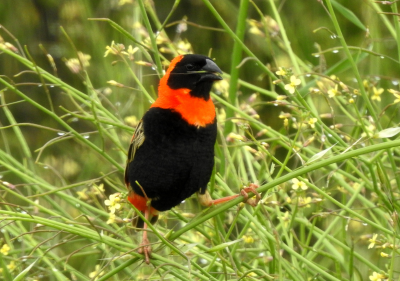
(Photo credit: Pete Read)
This bird has a scattered range throughout southern Africa but is conspicuous in the Cape – and I couldn’t resist including it here owing to its beauty! Small but striking, is widespread along the route we are visiting, but tends to localized in grassy areas near marshes. It is part of the family of birds called weavers, and as that name suggests, uses grasses to deftly construct a bulky woven oval nest attached to stalks of vegetation. One male will breed with several females - up to seven females have been recorded on one male’s territory at the same time!
The above represent just a sample of the wonderful birds we could see among so much more on our Best of the Cape tour next August during the austral spring. Click here to learn more.
The above represent just a sample of the wonderful birds we could see among so much more on our Best of the Cape tour next August during the austral spring. Click here to learn more.


